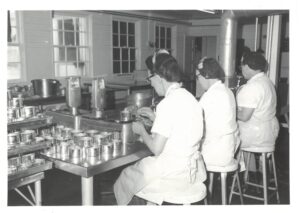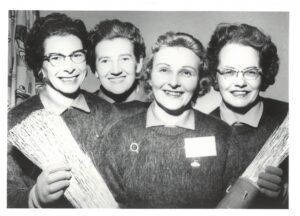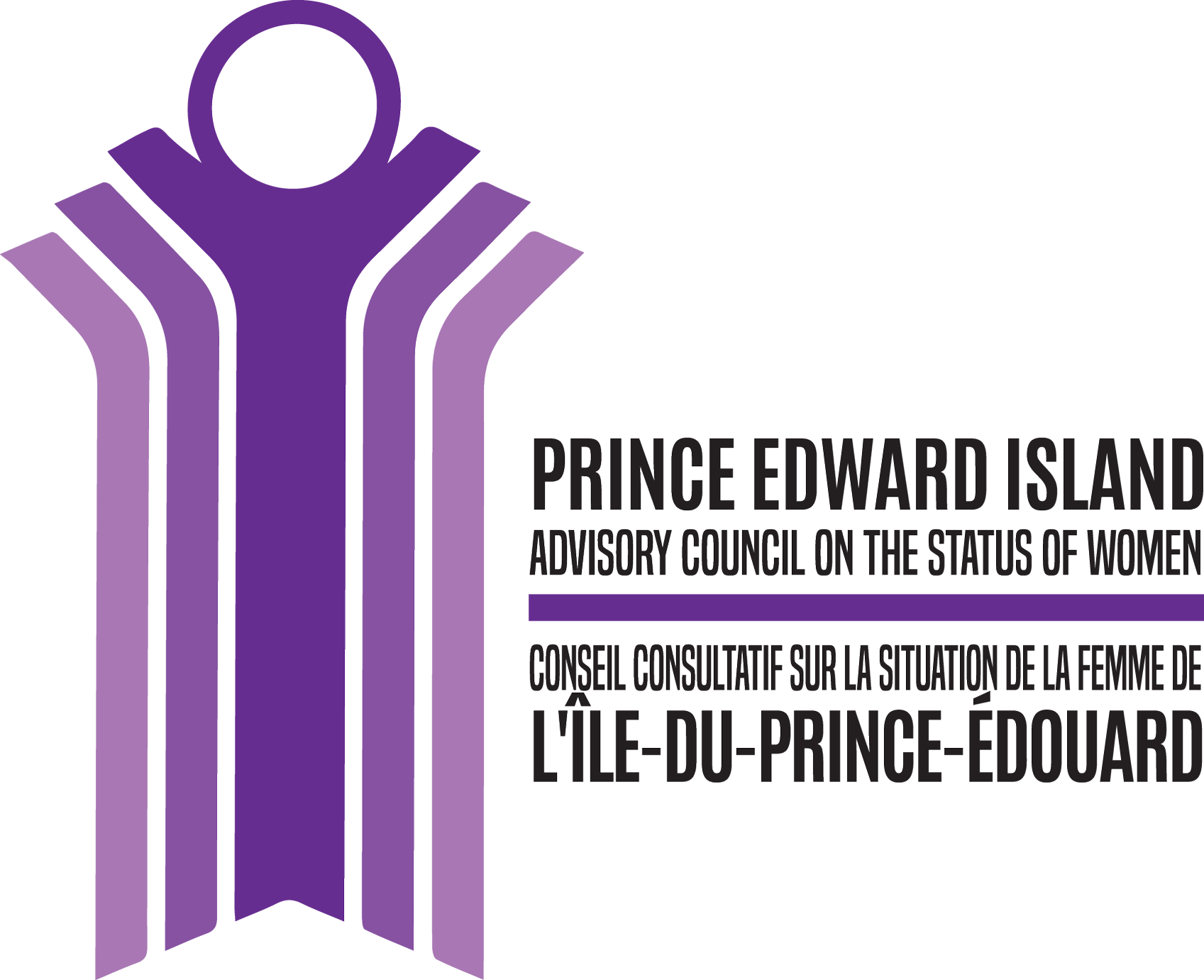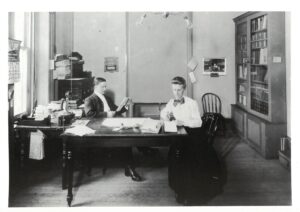On October 18, during Women’s History Month, we mark Persons Day in Canada, in commemoration of the day in 1929 when women were deemed “persons” under the law by the highest court of appeal in Canada, and women were deemed eligible to be appointed to the Senate of Canada. The decision did not include all women, excluding Indigenous women and women of Asian heritage, but it was a landmark moment in gender equality and the definition of rights in Canada, and it paved the way for increased participation in political and civic life for many women in Canada.
This Persons Day, as we continue to reflect on the 50-year history of the PEI Advisory Council on the Status of Women and prepare for a public celebration on October 23, 2025, we wanted to share a reflection from the 20th anniversary of the Council, by Marlene Russell Clark, Q.C., of Mount Stewart, one of PEI’s earliest and staunchest supporters of gender equality and the Advisory Council on the Status of Women. In the late 1960s, she completed a thesis entitled “The Franchise in Prince Edward Island and its Relation to Island Politics and Other Political Institutions” as part of her Master in Arts degree at Dalhousie University in Halifax, Nova Scotia. In the 1970s, she became the Advisory Council’s first executive secretary, which was, in effect, the Council’s first support staff.
When Marlene died in November 2018, her partner brought to the Council office the many files, books and photos she collected to record and celebrate women’s history in PEI. Her papers are currently entrusted to an historian of Island women’s history. Some of the photos she selected and printed from the public archives are included below.
NOTES for an Address
by
MARLENE R. CLARK
20th Anniversary
Prince Edward Island Advisory Council on the Status of Women
February 15, 1995
Beaconsfield, Charlottetown, Prince Edward Island
YOUR HONOUR, MADAME PREMIER, MADAME SPEAKER, MADAME MINISTER, MADAME LEADER OF THE OPPOSITION, DISTINGUISHED GUESTS, TOKEN MEN, AND WOMEN ALL:
I hope you realize that this is the only jurisdiction in the world where it is possible to begin a speech with that line of introduction.
That we can do so, in 1995, is due in no small measure to the success of the Prince Edward Island Advisory Council on the Status of Women. Without the dedication and diligence of many of you here today, dedication and diligence aimed single-mindedly at promoting equality of women, the history of our province might have unfolded rather differently over the past twenty years.
When I look around the room at familiar faces, as well as many new ones, I have to ask: Has it really been 20 years? Only twenty years? It seems like a lifetime ago – but then again, in the mysterious ways of memory, it seems like only yesterday.
Well, it was only yesterday – 21 years ago yesterday – Valentine’s Day – a cold, stormy Valentine’s Day. That was the day that the Government of Prince Edward released to the public a report prepared for it by a government-appointed group called the Advisory Committee on the Status of Women. That committee, chaired by Jean Canfield, was established by the province in response from a request from Ottawa – Ottawa had asked all provinces a simple question with far-reaching consequences: What do the provinces plan to do about those recommendations that were made by the federal Royal Commission on the Status of Women and that could be implemented only within provincial jurisdiction? The PEI answer was to establish a committee.
I remember the Valentine’s Day that marked the release of that report because I had put considerable work into its contents and I had made the decision on how many copies to have printed. I was advised that the usual publication run for a government document at that time was 200 copies unless some type of blockbuster was forecast. I hoped the report would receive wider distribution than 200 copies but I thought it would be better in the long-term to be able to say that the report was so popular that we had to do a second printing than to have all the boys saying that there were piles of unread copies gathering dust at the Queen’s Printer. So I ordered 200 copies. And, on that cold, stormy day, I was at home – where there was no telephone. I trudged through the snow in mid-afternoon to call the office – not knowing whether the office would even be open and fully expecting no one would venture out on such a day to get the report. I was most gratified to learn distribution was so brisk only 20 copies were left. The strategy paid off – even though the Queen’s Printer people have probably never forgiven me for being so poor with my forecasting. We eventually went to a third printing of 500 copies – so the report became something of a record-holder in government publishing annals in this province.
The interest generated by that report and its recommendations led government to adopt the Advisory Council model that concurrently was being accepted in several other provinces.
Let me set the stage a bit for you in terms of the scene in 1975. The decision of the courts in Murdoch v. Murdoch, a family law case involving the division – or, more accurately, the non-division – of prairie farm property following the breakdown of a marriage, was a major concern to a lot of farm wives and other married women. In the realm of pension plans, the usual rule was simple: If a male employee died, his widow might get a pension. If a female employee died, so did her pension, including her contributions.
Mrs. Canfield was involved in attempting to get women employed on the car ferries at Borden, where women were employed only as washroom attendants for the ladies’ loo and management was taking the position they couldn’t hire women for other positions on board the vessels because there were no women’s washrooms for females who were not passengers. Once that battle was won – at least they hired some women as cooks – they refused to hire female students to direct cars on the pier because the pier was much too dangerous and the orange plastic traffic markers placed in front of each line up of cars were much too heavy for those management termed “the fairer sex.” Simultaneously, the president of Canadian National was bragging to the Financial Post of a $6 million consultant’s report to improve the status of women in relation to the company.
On the local scene, there were no women lawyers. Indeed, the Bar was embroiled in a messy little issue – whether to allow two female law students from Dalhousie who were summer students with the Department of Justice to use the law library at the court house.
The province had funding available to send Island students off to an agricultural course at N.S.A.C. in Truro as a prelude to the study of veterinary medicine but N.S.A.C. would not admit female students to the course on grounds that this girlish interest in being veterinarians was nothing more than a passing fad.
I recall vividly one exercise the Advisory Council undertook in its early years. We called on each of the five school boards in the province to discuss a number of issues relating to the status of women – the range of topics covered the gamut from the scarcity of women principals in the schools to sex-stereotyping in textbooks. What an eye-opener that was, as we met with the 15 trustees (all of whom were male) in each of the districts.
Let me share with you a couple of small, but telling, incidents. Two music students were applying for a teaching position at the high-school level. The female student had a degree in music from Mount Allison University and she had just successfully completed the course work for a B.Ed. from U.P.E.I. The male student had a few music courses and had just flunked two exams so he would not be eligible to graduate with his B.Ed. Guess who the Board hired? The male who flunked. We asked why and got no coherent answer, except that one trustee said they would be more than happy to hire the female graduate the next time there was an opening in the elementary school level where she undoubtedly would be much “happier.”
That same evening, we asked that Board why they had no women hired as bus drivers for the school buses. It was apparent from the facial expressions and silence that greeted the question that most trustees had never considered such heresy. Finally, one brave chap spoke up. “You must realize,” said he, “that we are concerned first and foremost with the safety of children. We can only hire people who will ensure the safety of children.” As the Chair of the Advisory Council politely asked if he was suggesting that mothers were not into child safety issues, the Superintendent for the School Unit had the grace to hide his face and slid rather low in his chair, while several Board members squirmed in obvious embarrassment. And we moved on to other topics.
So, times have changed. There has been great progress. Right? We have a Family Law Reform Act, there are more than 50 women lawyers in the province, women drive school buses, work on the car ferries, sit on juries, get invited to the New Year’s Levees. We have elected more women to the Legislature than the combined totals for the other three Atlantic provinces since Confederation. We have women as Lieutenant-Governor, Premier, Speaker and Deputy Speaker of the Legislature, President and Chancellor of the University, even a token judge of the Supreme Court, although the last three appointments have all been males.
But I suggest to you that if you think these obvious signs of progress signify that the goal of equality for women has been attained, you are badly deluded.
Consider:
The woman today who ends a bad marriage by way of a divorce is virtually guaranteed a half share of the matrimonial home and perhaps a share in some of the other assets. The woman who does not end a bad marriage in divorce can face widowhood with nothing. She has no automatic right to any interest in the matrimonial home or in any other family or business asset.
In 1978, when the Family Law Reform Act was passed, we were the “vanguard of the revolution” – the second province in Canada with family law reform. When that legislation was passed, the Advisory Council on the Status of Women was critical of the Family Law Reform Act because it failed to provide for equitable sharing of business assets and because it did not cover dissolution of a marriage by death. Those gaps are still there and if any women’s groups have been complaining, their complaints have been low and feeble.
Consider:
We have a project going on down the road – a mega project, about 35 miles from here. Good jobs and lots of them with good money. How many women are off right now on training courses for those fixed link jobs? Over the past five years while everyone was debating the pros and cons of this project, how many women’s organizations were urging women to train in welding and rebar steel at $15 and $20 an hour instead of selling gloves at $5 an hour?
Consider:
Twenty years ago, the public service in this province was in the forefront in the elimination of secretarial rug-ranking. The work being done in that area resulted in personnel from the P.E.I. Civil Service Commission being invited to go to other jurisdictions to explain how it had been accomplished. From my perspective – when I hear that Ministers and Deputy Ministers get shuffled around and take their secretarial staff with them – it means just one thing – rug-ranking is back in the public service.
While it may be unseemly to dwell on the negative when the occasion is one to celebrate the positive, I think it is fitting to remember not only how far we have come – but also to reflect on how much further we have to go.
Let us take this opportunity, not only to salute the success of past Councils, but to challenge those to whom the torch has been passed. May the Advisory Council on the Status of Women continue vigorous endorsement in furtherance of equality goals.
Here are a few of the photos Marlene Clark selected from the PEI Public Archives and Records Office, at a time when she would have had to search through photos physically and order print copies. She was attracted to themes of labour and careers, sports, and women’s war service, among other things.

Original Charlottetown Camera Club 1967 description: “Jenkins Canning Factory, Summerside” PEIPAROAcc2320/18-3

Original Charlottetown Camera Club 1967 description: “First P.E.I. Diamond ‘D’ Rink, 1961 Left to right: Elizabeth (Liz) MacDonald, skip; Sally Rodd, first stone; Evelyn (Ev) Goss, 2nd stone; Nora MacDonald, mate; This ring represented P.E.I. at Ottawa in the first Canadian Ladies’ Curling Championships, sponsored by Dominion Stores Ltd. The same team went to Regina in 1962. Again in 1967, Mrs. MacDonald with a new rink – Peggy Dalziel, Barbara Squarebriggs, and Marie Toole, (mate) played in the finals at Mount Royal, Quebec” PEIPARO Acc2320/87-9



